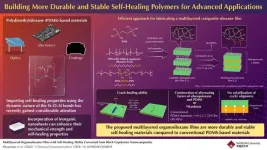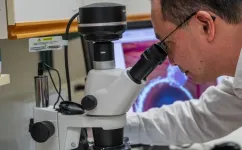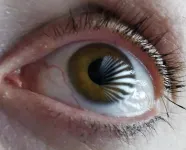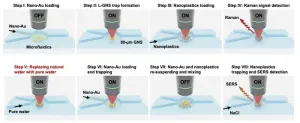Polysiloxane materials, such as polydimethylsiloxane (PDMS)-based elastomers, exhibit a self-healing capability by the introduction of silanolate (Si–O–) groups. This ability stems from their dynamic siloxane (Si–O–Si) bonds, which can break and reform to repair damage. Their self-healing properties could make them valuable in applications like protective coatings for use in various fields, such as optics, electronics, and aerospace.
To improve the properties of PDMS-based materials, they have been combined with inorganic fillers such as nanoparticles or nanosheets. Generally, the introduction of nanosheets into polymers leads to the formation of a layered structure that exhibits superior thermal, mechanical, and gas barrier properties. Furthermore, an improved crack-healing ability of oriented films has been reported. This improvement is attributed to polymer diffusion concentrated in the in-plane direction.
Researchers at Waseda University, Japan, have made significant progress in enhancing self-healing siloxane materials by developing a more efficient method for fabricating multilayered films. In a study published on 06 January 2025, in Volume 61, Issue 16, of the journal Chemical Communications, a team led by Professor Atsushi Shimojima, with Research Associate Yoshiaki Miyamoto and Assistant Professor Takamichi Matsuno, fabricated a composite film comprising highly cross-linked organosiloxane (silsesquioxane) and grafted PDMS layers using a self-assembly process.
“Replacing traditional materials with our self-healing material, which is less susceptible to deterioration and has high hardness, would be in high demand for maintenance-free and durable applications,” says Miyamoto, the lead author of the study.
The researchers began by depositing a solution containing 1,2-bis(triethoxysilyl)ethane, Pluronic P123 (a PEO–PPO–PEO triblock copolymer, where PEO stands for poly(ethylene oxide) and PPO stands for poly(propylene oxide)), and a PEO–PDMS–PEO block copolymer onto a silicon or glass substrate using spin-coating or drop-casting techniques. This process formed a thin film with a lamellar (layered) structure.
The film was then calcinated in air at 170 °C for 4 hours, resulting in the removal of the PEO and PPO blocks. This process left behind a multilayered structure composed of silsesquioxane and PDMS layers.
To impart self-healing properties to the film, Si–O– groups were introduced. These groups promote rearrangement and reconnection of the siloxane (Si–O–Si) networks. To achieve this, the film was immersed in a solution of tetrahydrofuran, water, and potassium hydroxide (KOH). In this process, hydroxide ions (OH–) from KOH removed protons (H+) from silanol (Si–OH) groups, converting them into Si–O– ions. The final film could repair micrometer-scale cracks when heated to 80 °C at 40% relative humidity for 24 hours.
The film showed superior properties compared to conventional PDMS-based materials. The cross-linked organosiloxane layers provided greater rigidity and served as a barrier against the volatilization of cyclic siloxanes, addressing the limitations of traditional PDMS materials. While conventional self-healing PDMS elastomers have a hardness of 49 MPa, the final self-healing film exhibited a hardness of 1.50 GPa.
“This innovative multilayered design allows our material to be both harder and more heat-resistant than existing self-healing siloxane-based materials, paving the way for more durable and reliable applications,” says Miyamoto.
With its high hardness and self-healing properties, this material is well-suited for protective coatings, flexible electronics, and other applications that require long-lasting performance.
***
Reference
Authors: Yoshiaki Miyamoto1, Takamichi Matsuno1,2,3 and Atsushi Shimojima1,2,3
Title of original paper: Multilayered organosiloxane films with self-healing ability converted from block copolymer nanocomposites
Journal: Chemical Communications
DOI: 10.1039/D4CC05804F
Affiliations
1Department of Applied Chemistry, Faculty of Science and Engineering, Waseda University, Japan
2Waseda Research Institute for Science and Engineering, Waseda University, Japan
3Kagami Memorial Research Institute for Materials Science and Technology, Waseda University, Japan
About Waseda University
Located in the heart of Tokyo, Waseda University is a leading private research university that has long been dedicated to academic excellence, innovative research, and civic engagement at both the local and global levels since 1882. The University has produced many changemakers in its history, including nine prime ministers and many leaders in business, science and technology, literature, sports, and film. Waseda has strong collaborations with overseas research institutions and is committed to advancing cutting-edge research and developing leaders who can contribute to the resolution of complex, global social issues. The University has set a target of achieving a zero-carbon campus by 2032, in line with the Sustainable Development Goals (SDGs) adopted by the United Nations in 2015.
To learn more about Waseda University, visit https://www.waseda.jp/top/en
About Dr. Yoshiaki Miyamoto from Waseda University
Dr. Yoshiaki Miyamoto is a Research Associate at the School of Advanced Science and Engineering, working under the supervision of Professor Atsushi Shimojima. His research focuses on the relationship between material structure, composition, and self-healing properties, particularly within the realm of siloxane-based materials. He explores factors such as network flexibility, swelling behavior, and dynamic bond rearrangement. His research has produced publications demonstrating expertise in designing self-healing materials with improved mechanical properties and thermal and chemical stability. Dr. Miyamoto's research contributes to the advancement of functional materials with potential applications in coatings, adhesives, and other areas where self-healing capabilities are crucial.
END





